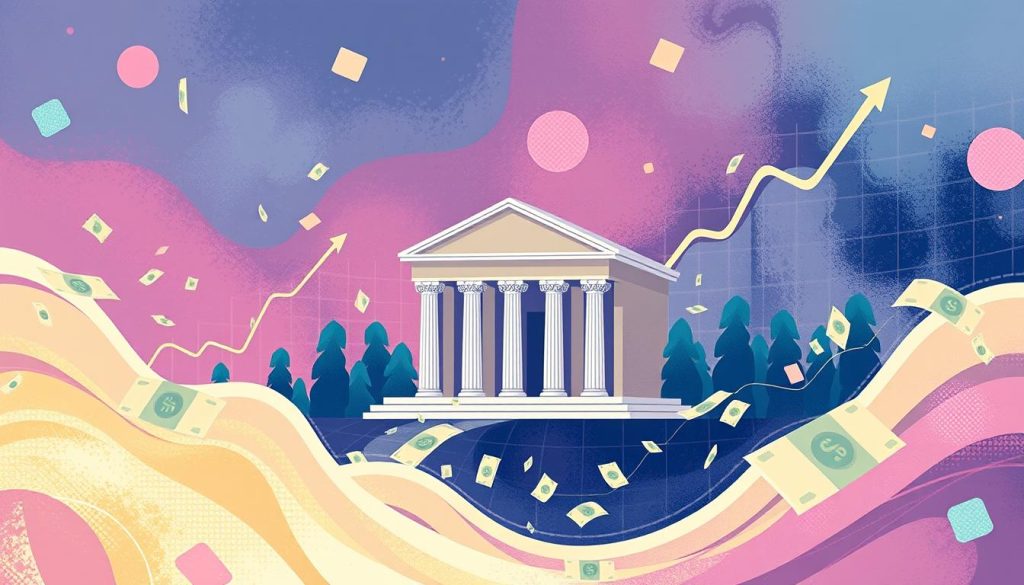In today’s complex economy, knowing about quantitative easing (QE) is key for financial pros. It’s a vital tool for those working with corporate bonds, fixed-income securities, and debt instruments. QE helps shape the investment-grade and high-yield bond markets, affecting bond ratings, yields, and maturities1.
Central banks like the Federal Reserve use QE to boost a slow economy when lowering interest rates doesn’t work1. They create new money to buy government bonds. This increases the money supply, lowers long-term interest rates, and encourages lending and spending to help the economy grow1.
Key Takeaways
- Quantitative easing is a monetary policy used by central banks to stimulate the economy during economic stagnation
- QE involves the central bank purchasing government securities to increase the money supply and lower interest rates
- The goal of QE is to encourage lending, investment, and consumer spending to boost economic growth
- QE can have both positive and negative impacts, such as making loans more affordable but also potentially fueling inflation
- Understanding the mechanics and effects of QE is crucial for financial professionals managing corporate bond portfolios and other fixed-income assets
Understanding Quantitative Easing
What is Quantitative Easing?
Quantitative easing is a special way for central banks, like the2 Federal Reserve, to help the economy. They create new money to buy government bonds from banks2. This makes more money available and lowers interest rates. The goal is to get people and businesses to spend and invest more.
The Federal Reserve has used this method many times to help the economy and markets2. During the Great Recession, they bought $600 billion in mortgage-backed securities in 20082. Then, they added another $750 billion in MBS and $300 billion in Treasury bonds in 20092. Recently, they bought $3 trillion in assets and started a bond-buying program in 2020, adding $120 billion each month2.
Quantitative easing is a key tool for central banks to help the economy when it’s struggling. By making more money available and lowering interest rates, they try to increase lending, investment, and spending. This helps the economy grow and stay stable.
“Quantitative easing is a monetary policy in which a central bank purchases government securities or other securities from the market in order to lower interest rates and increase the money supply.” – Federal Reserve
When is Quantitative Easing Used?
Quantitative easing is a key tool for central banks when normal methods like lowering interest rates don’t work well enough to boost a slow economy3. It’s used when an economy faces issues like recession, stagnation, high inflation, and high interest rates, leading to a slowdown3.
Central banks buy government securities to increase money supply. This helps lower long-term interest rates, making borrowing and lending easier. It aims to boost economic growth and recovery3. During the Great Recession, the Federal Reserve bought over $4 trillion in assets from 2009 to 2014 to help the economy recover4. The Bank of Japan has been using it for over a decade to fight deflation4.
The COVID-19 pandemic led central banks to restart quantitative easing programs3. The Federal Reserve started buying assets again in March 2020, with no limits, to support the economy4.

Quantitative easing is a strong tool for central banks, but it’s used as a last option when other methods don’t work3. By adjusting asset purchases based on economic conditions, central banks can help stabilize markets, increase lending, and support sustainable growth4.
The Mechanics of Quantitative Easing
How Quantitative Easing Works
Quantitative easing is a way for central banks to help the economy grow. They do this by buying government securities from banks and other financial groups5. This brings more money into the system, increases the money supply, and lowers bond prices. This makes interest rates go down, making it easier for people and businesses to borrow and spend5.
The main aim of this policy is to get the economy moving and create jobs. By making borrowing cheaper, the central bank hopes to increase bank lending, investment, and spending. This should lead to a stronger economy56.
Central banks have used quantitative easing during tough times, like the 2008-2009 Great Recession and the 2020 COVID-19 pandemic56. The success of these efforts has varied, depending on the economy’s state and the bank’s actions6.

“Quantitative easing is a tool that central banks can use to stimulate the economy, but it’s not a magic bullet. Its effectiveness depends on the underlying economic conditions and the scale of the central bank’s intervention.”
Impacts of Quantitative Easing
Quantitative easing (QE) aims to boost the economy but has some side effects. The more money in circulation can cause inflation if there’s not enough new goods and services7. This can make imports cost more, hurting businesses that rely on imports7.
QE might also widen the gap between rich and poor, making things worse for those who are already struggling7. Banks might pull their money out of the country, looking for better opportunities elsewhere7.
The effects of QE are complex and far-reaching. It’s meant to help the economy but can have other effects that need careful thought7. It’s important for experts and leaders to understand these impacts well.
| Impact | Description |
|---|---|
| Inflation | More money can lead to higher prices if there’s not enough new goods and services7. |
| Currency Value | QE can lower the value of the currency, making imports pricier and affecting import businesses7. |
| Wealth Inequality | QE might help the rich more, making the gap between rich and poor bigger7. |
| Capital Flight | Banks might move their money to other markets or places, not lending in their own country7. |
“The economic impacts of QE are complex and multifaceted. While the policy aims to stimulate the economy, it can also have unintended consequences that policymakers must carefully navigate.”
Studies show that quantitative easing (QE) can boost innovation by moving money to companies that are innovative8. The Corporate Sector Purchase Program (CSPP) made companies invest more in research and development8.
This effect was seen right after the program started and got even stronger over time8. The corporate bond purchases by the central bank under the CSPP helped innovative companies by lowering their debt costs87.
Quantitative Easing and Corporate Bonds
Quantitative easing (QE) greatly affects the corporate bond market9. The Federal Reserve buys assets to lower long-term interest rates. This makes corporate bonds more appealing to investors, raising their prices and lowering their yields9. It also makes it cheaper for companies to borrow money or pay off debts.
But, QE’s effects on corporate bonds depend on many things9. Companies with investment-grade debt see steady drops in borrowing costs. Those with high-yield bonds see more mixed results9. Riskier companies with debts that mature soon feel the most impact from changes in federal funds rates and policy during QE.
10The corporate bond market reacts differently to the Federal Reserve’s QE, depending on the bond’s credit rating and sector10. Credit spreads fall more for investment-grade bonds than high-yield bonds after QE announcements. This shows QE has a quick effect on the risk of default.
10After QE announcements, the corporate bond market gets more liquid. Bid-ask spreads narrow and more deals happen10. This means the Federal Reserve’s actions help dealers manage their inventories better, making investors less eager to sell and improving the market.
Financial experts need to keep an eye on these changes when handling corporate bond portfolios9. QE has had a limited effect on public firms, with little impact on investment and sales. Yet, it has still changed the corporate bond market a lot9.
| Measure | Impact of QE |
|---|---|
| Bond Yields | Significantly reduced across maturities and bond grades, especially for investment-grade bonds9 |
| Credit Spreads | Decreased more for investment-grade bonds than high-yield bonds following QE announcements10 |
| Liquidity | Improved, as evidenced by reduced bid-ask spreads and increased transaction volumes10 |
| Firm-level Impacts | Limited, with muted effects on factors like investment and sales, but some positive outcomes observed for firms with greater yield reductions9 |
“Quantitative easing has undoubtedly shaped the corporate bond market in significant ways, with varying impacts on different segments of the market.”
Conclusion
As a financial expert, knowing about quantitative easing is key in today’s complex economy. This tool helps you make better choices for your clients and their investment strategies.
The corporate bond market is greatly affected by quantitative easing. Corporate bonds can offer higher returns because they carry more risk11. Agencies like Moody’s, Standard & Poor’s, and Fitch are important in rating these bonds’ risk and potential returns11. This knowledge helps you guide your clients in the corporate bond market.
Keep improving your skills in quantitative easing and corporate bonds. Stay updated on market trends, issuer finances, and other factors that affect investment strategies11. With a strong grasp of this economic policy and its market impact, you can help your clients succeed in the changing finance and economics world.
FAQ
What is quantitative easing?
Quantitative easing is a tool used by central banks to help the economy when it’s slow or in recession. It involves buying lots of government securities to increase money and lower interest rates.
When is quantitative easing used?
Central banks use it as a last option when normal tools like low interest rates don’t work. It’s used when the economy is slow and high interest rates and inflation are making things worse.
How does quantitative easing work?
Central banks buy government securities from banks and other financial groups through open market operations. This adds money to the banks’ reserves. The increased money and demand for securities raise their prices, lowering interest rates.
What are the potential impacts of quantitative easing?
This policy aims to boost the economy but can have downsides. It might lead to higher inflation if there’s not enough new production. It could also make the currency value drop, making imports pricier and hurting import businesses.
It might favor the wealthy more, making wealth gaps wider. Banks might also move money to other markets, not lending at home.
How does quantitative easing affect the corporate bond market?
It can greatly affect the corporate bond market. Lower interest rates from the central bank make corporate bonds more appealing to investors. This raises their prices and lowers their yields.
It makes it easier and cheaper for companies to borrow money or refinance. But, the impact on corporate bonds depends on the issuer’s credit, the bond’s maturity, and market conditions.

